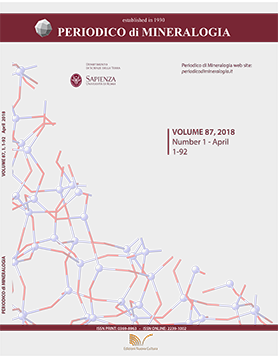Crystal-chemistry of sulfates from Apuan Alps (Tuscany, Italy). I. Crystal structure and hydrogen bond system of melanterite, Fe(H2O)6(SO4)•H2O
DOI:
https://doi.org/10.2451/2018PM759Keywords:
melanterite, sulfate, crystal structure, hydrogen bonds, Fornovolasco, Apuan Alps.Abstract
Melanterite, ideally Fe(H2O)6SO4·H2O, from the pyrite + iron oxide ore deposit of Fornovolasco (Apuan Alps, Tuscany, Italy) has been fully characterized through electron microprobe analysis, micro-Raman spectroscopy, and X-ray diffraction. Melanterite occurs as cm-sized greenish fibrous efflorescences on pyrite or rare pseudo-octahedral colorless crystals, up to 5 mm in size. Electron microprobe analysis (in wt% - average of ten spot analyses normalized to 100 wt% without H2O) gave: SO3 52.98, FeO 45.53, MgO 1.49, sum 100.00. Assuming the occurrence of 7 H2O groups per formula unit, the chemical formula can be written as (Fe0.95Mg0.06)Σ1.01(SO4)·7H2O. The Raman spectrum of melanterite is characterized by bending and stretching modes of (SO4) and H2O groups. Melanterite crystallizes in the space group P21/c, with unit-cell parameters a = 14.0751(8), b = 6.5014(4), c = 11.0426(6) Å, β = 105.632(3)°, V = 973.11(10) Å3, Z = 4. The crystal structure of melanterite has been refined down to R1 = 0.024 on the basis of 3457 reflections with Fo > 4σ(Fo) and 179 refined parameters. It can be described as formed by undulating layers showing the alternation, along a, of SO4 groups and Fe-centered octahedra coordinated by H2O groups. The occurrence of a complex hydrogen bond system plays a fundamental role in the crystal structure of melanterite.


